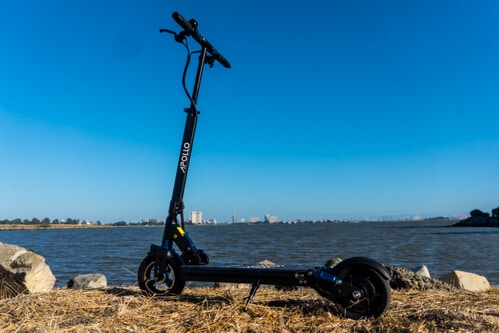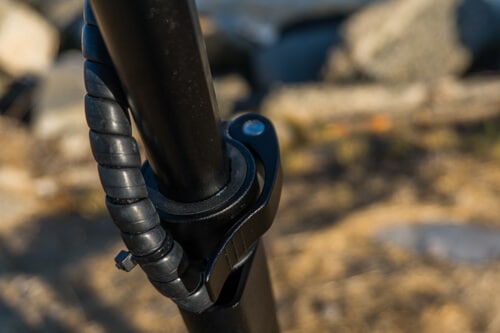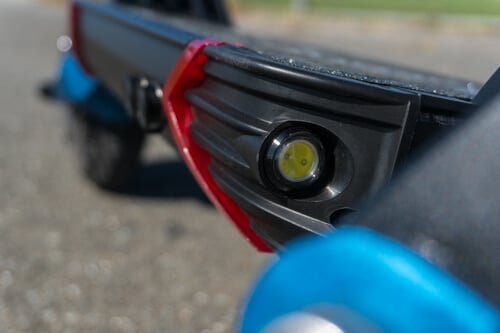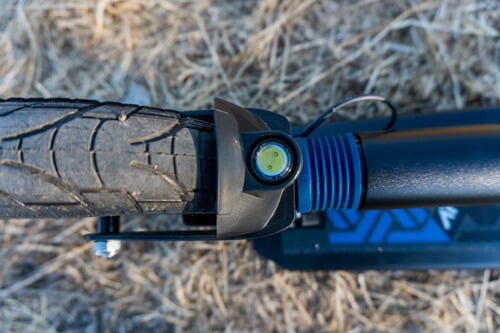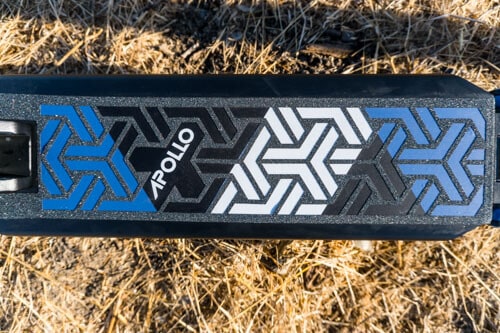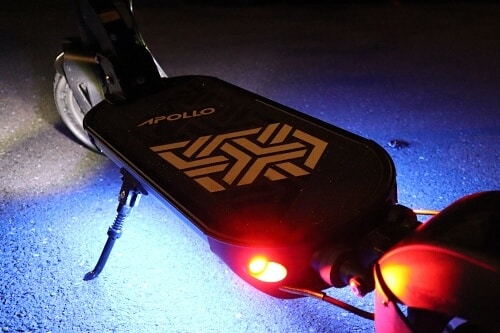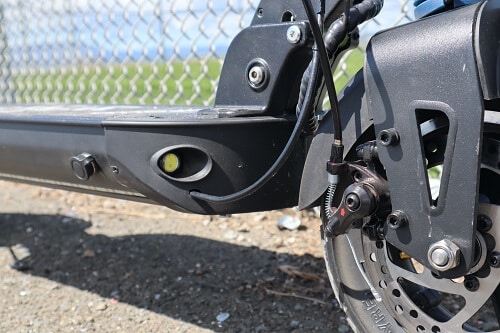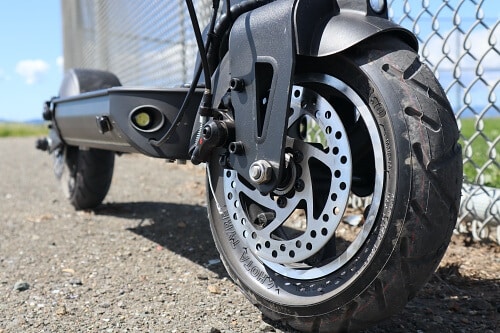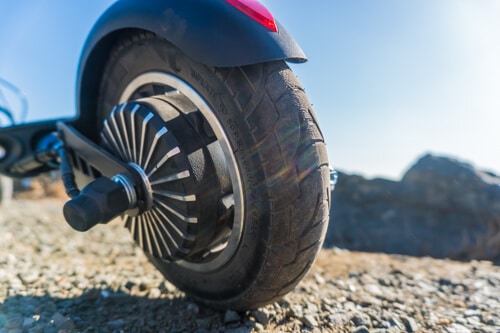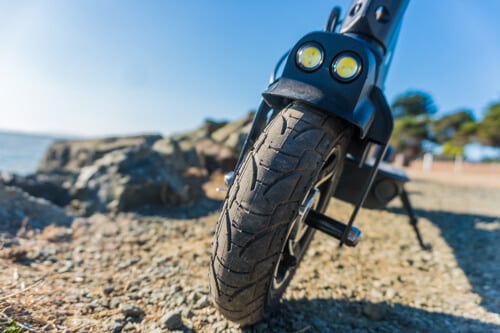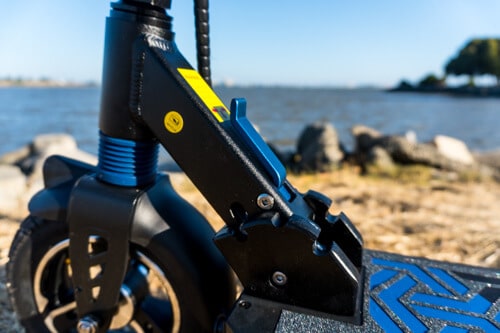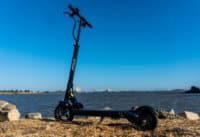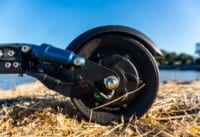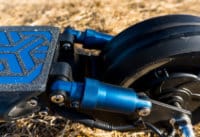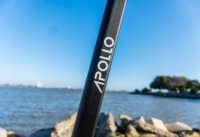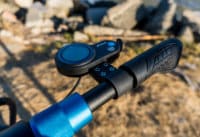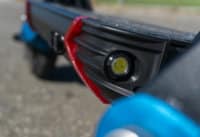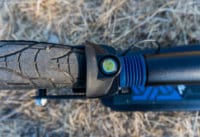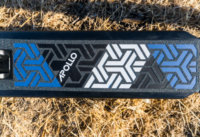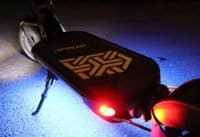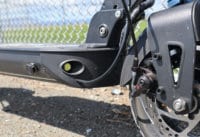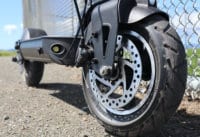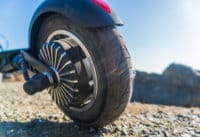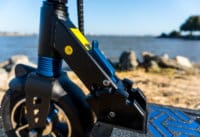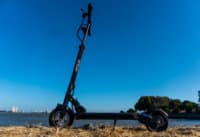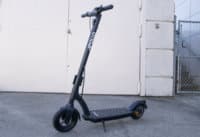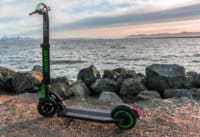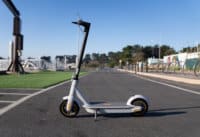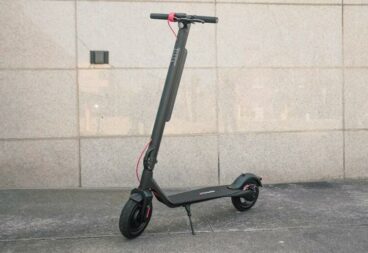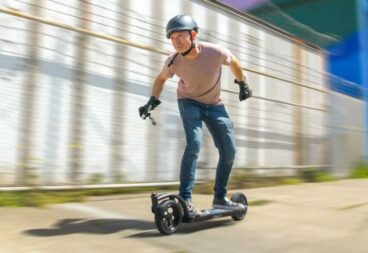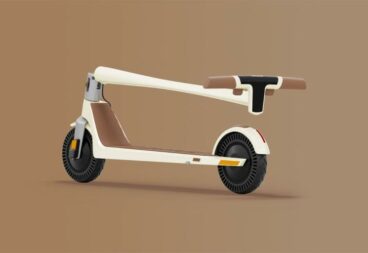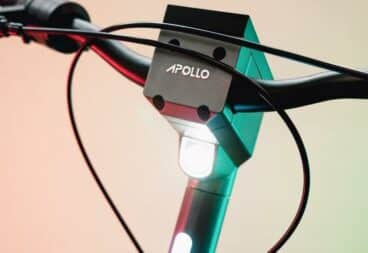Apollo Light
$799
In this hands-on Apollo Light review, we take a detailed look at Apollo’s entry-level electric scooter. The Light has a similar form factor to Apollo’s other scooters but is lighter, less expensive, and suitable for those who are looking to get their feet wet in the world of electric scooters. The Light is a direct competitor with the Zero 8 and Horizon, which are all made by Unicool.
Technical Specifications
| Tested top speed: 22.0 mph* | |
| Tested range: 16.3 mi* | |
| Weight: 39 lb* | |
| Max rider weight: 220 lb | |
| Water resistance: IP54 |
Highlights
| Solid entry-level scooter | |
| Comfortable full suspension | |
| Lightweight and folds very compactly | |
| IP54 water-resistance | |
| Handlebars tend to loosen |
Our content is independent, but buying through our links may earn us a commission.
Summary
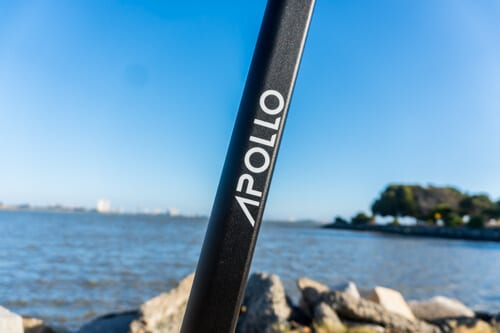
Our Take: Entry-Level Lightweight with Sweet Suspension
The Apollo Light electric scooter is an entry-level model and is basically a paired-back version of the Apollo City, one of the most well-rounded urban commuting machines. It has a front and rear spring suspension that tames potholes, easy-to-use controls, and tested top speed of 22.0 mph. Like its namesake implies, the Light is … light and weighs a very manageable 37 lb.
If you’re looking into buying your first electric scooter or just migrating away from shared scooters, the Light is one you’ll want to consider. It will be significantly faster than shared or budget scooters that are capped around 15 mph. Its full suspension is more suitable for urban environments than shared scooters that typically have none.
Finally, an often overlooked feature of an electric scooter is the actual distributor/retailer/seller. Apollo has established itself as a leader in both warranty and customer support. They are well-regarded in online electric scooter communities.
Best Alternatives and Competitors
| Model | Top Speed** | Range** | Weight** | Price |
| Apollo Light | 22.0 mph | 16.3 mi | 39 lb | $799 |
| Apollo Air | 15.6 mph | 13.9 mi | 34 lb | $699 |
| Inokim Light 2 | 20.7 mph | 16.0 mi | 30 lb | $999 |
| Segway Ninebot Max (G30LP) | 18.0 mph | 13.6 mi | 39 lb | $720 |
Apollo Light Review
Performance Summary
| Acceleration (0 to 15 mph) | 4.9 seconds |
| Acceleration (0 to 20 mph) | 8.2 seconds |
| Top speed | 22.0 mph |
| Braking distance (15 to 0 mph) | 17.6 feet |
| Range | 16.3 miles |
| Hill climb | 15.1 seconds |
Acceleration
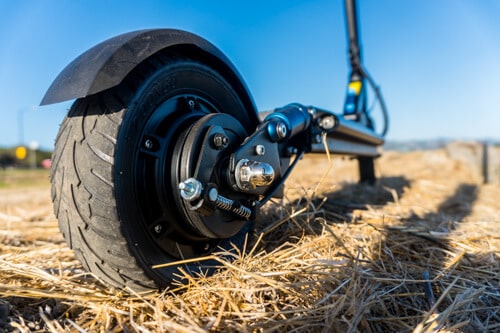
The Light is propelled by a 600-watt electric motor. It has an ESG Certified acceleration of just 4.9 s (0 to 15 mph) and 8.2 s seconds to 20 mph. This is moderate pick-up-and-go and will beat out a typical shared scooter, but it’s certainly not a beast-mode racing scooter.
The benefit of having quick acceleration (aside from just being fun) is that it can often help you get out ahead of traffic or merge over quickly.
Hill Climbing

The Apollo Light had a 15.1 s hill climb time with an average speed of 9.1 mph. This is moderate hill-climbing performance. The Light should handle most hills but expect to slow down on steeper ones. If you’re heavier than 185 lbs, expect to crawl up steeper hills.
It is better than the run-of-mill shared scooter like the Segway Ninebot Max, which took 17.0 s at an average speed of 8.0 mph.
For our ESG certified hill climb performance test, we use the same 200 ft, 10% grade hill with a 165 lb rider.
Top Speed
The Apollo Light has an ESG Certified top speed of 22.0 mph.
Range
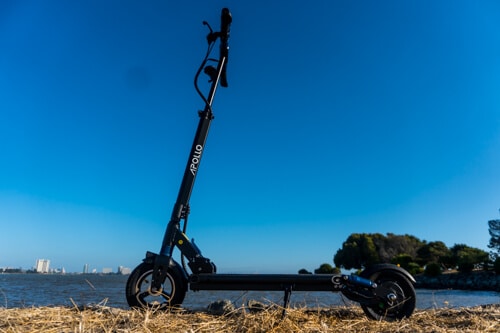
The Apollo Light has an ESG Certified range of 16.3 mi, thanks to its 490 watt-hour Dynavolt lithium-ion battery pack.
We perform all our range tests under the same condition on an urban test loop. The rider weighs 165 lb and rides the scooter as quickly as possible in its fastest mode. We find this is an accurate simulation of typical mileage; if you are riding continuously at the maximum speed, your mileage will be less.
You can compare the tested range of this scooter with others on our real-world testing page.
Braking
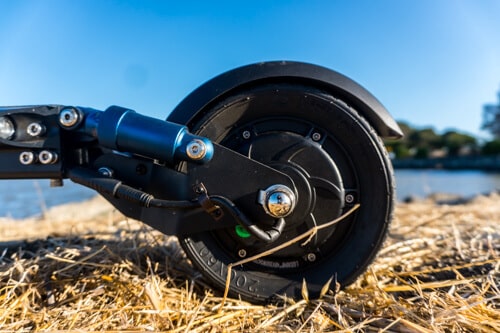
We tested the 15 mph to 0 mph braking distance of the Light and got 17.6 ft — a solid result and on par with scooters with similar brake configuration.
The Light has both a rear drum brake and a regenerative motor brake. We appreciate the redundancy of a dual braking system. Still, we really like to see braking on both wheels for maximum performance and safety. On the Light, both the regen and drum brake are on the rear wheel. Despite our criticism here, this configuration is not uncommon in scooters in this price category.
You’ll need to step up to the more premium Apollo City for a triple-redundant braking system with brakes on both wheels.
Ride Quality
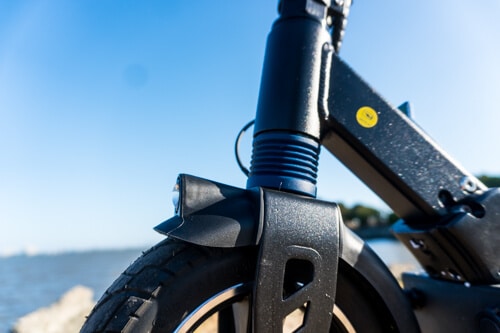
Like its bigger brother, the Apollo City, the Light has ample deck size and a full spring suspension. The front tire is air-filled (pneumatic) while the rear is solid. Ride quality is maybe 70% as plush as that of the City (which has an air-filled rear tire), but you won’t have to worry as much about flats.
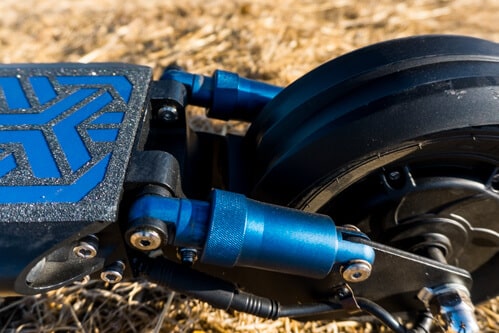
According to our own study, 80% to 90% of flats occur on the rear wheel. By having a solid rear wheel, this massively reduces your chances of a flat. The downside to the solid tire is reduced traction in wet conditions. The ride quality isn’t as enjoyable as having dual air-filled tires.
For the front air-filled tire, learn more about preventing flats.
Apollo Light Features
Portability
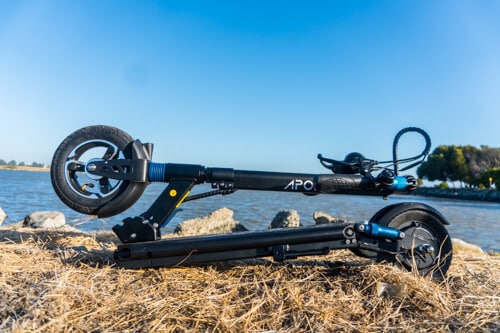
The Light is a very portable scooter thanks to its 37 lb weight and triple folding mechanisms. Once fully folded, the Light is just 39 by 7 by 39 in.
Unless you’re willing to drop down to an ultra-portable scooter like the UScooters Booster GT / E-TWOW GT 2020, you won’t find many lighter quality scooters that still have a full suspension.
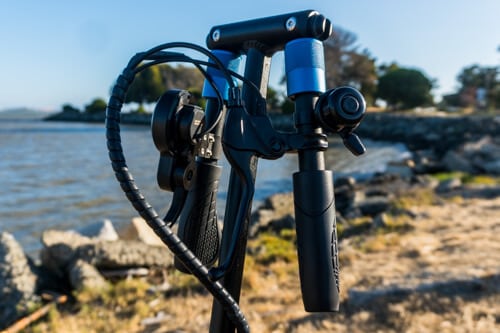
All folding mechanisms are relatively smooth to activate and tight when locked into place. Like other scooters with the screw-style mechanism on the folding handlebars, the Light tends to loosen up slightly on longer rides. Not a safety issue, but an annoyance we hope to see remedied in future versions.
Cockpit
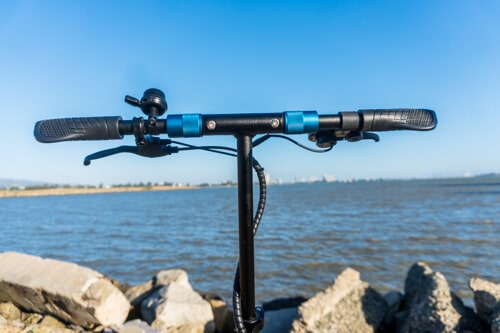
Some scooters have complicated cockpits with tons of different weird buttons with confusing labels. Not so with the Apollo Light. The Light has a very straight forward cockpit with a single brake lever, a bell, LCD display, and finger trigger throttle, which is an adapted QS-S4 LCD throttle.
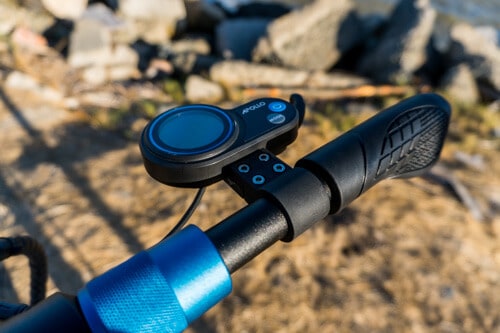
The brake lever controls both the drum brake and the regenerative brake. As soon as you start squeezing down on the brake lever, the regen activates.
A recent addition to all Apollo scooters is a mechanical bell that is loud enough to alert pedestrians and bicyclists.
Lights
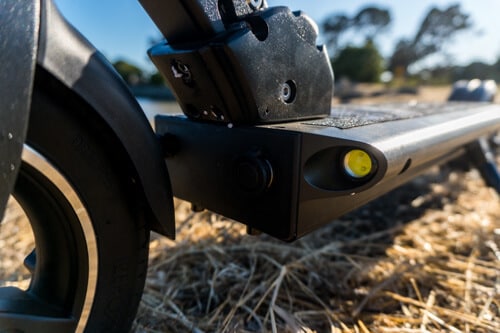
The Light has both front and rear LED lights mounted on the deck, as well as a front fender LED.
The lights are sufficiently bright in a pinch. However, the low-mounted headlight isn’t quite bright enough to illuminate the road far enough ahead when riding fast at night.
We recommend additional high-mounted bright LEDs if you’re frequently riding at night.
Learn more in our guide to riding at night.
Tires
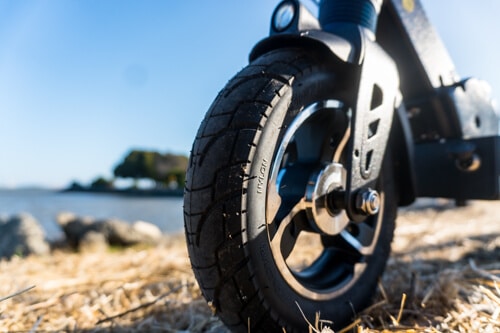
The Light has an 8.5 in front air-filled and a solid rear tire. We tend to prefer air-filled tires all around due to the cushioning effects they provide.
However, there is a benefit to solid rear tires: they don’t get flats. Rear tires tend to get flats almost 10 times more than front tires.
The Light strikes a nice compromise by having a solid rear tire will never get a flat, and the air-filled front one still provides some extra suspension.
Warranty / Post-Purchase Support
The Apollo Light has a warranty covering components like the structure and frame for 24-months then tapers down for consumable parts like tires and brake pads.
Apollo’s customer support is based in Canada and they can actually have a phone for live customer support from a real human. The team at Apollo is also very active in our online electric scooter community. Customers by and large report high level of satisfaction with their post-purchase support.
You can read the full text of the Apollo warranty here.
Build Quality
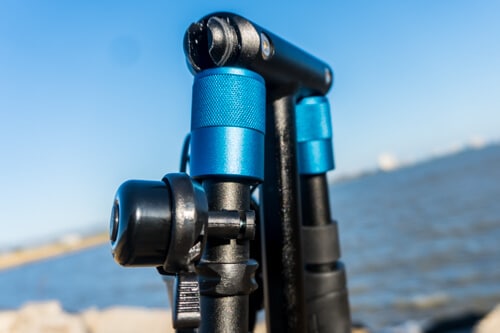
The Light has good build quality, but is a bit rougher around the edges than Segway or Xiaomi scooters. However, the Light should be a more durable scooter overall due to its heftier parts.
The Light has an IP54 water-resistance (IP rating) and can be ridden in light rain, but shouldn’t be submerged in water.
We noted no significant flaws in the Light’s construction, except the folding handlebars have tend to get a little play in them on long rides and need to be periodically tightened.
Apollo Light: Review Conclusions
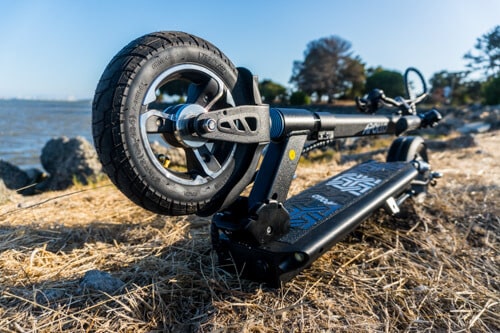
If you’re looking to dive into the world of electric scooters and looking at entry level models, like the Xiaomi M365 or Ninebot Max, you should also consider the Light.
Our content is independent, but buying through our links may earn us a commission.
If the Light doesn’t appeal to you, see our alternative suggestions. You can also check out our Editor’s pick of best electric scooters.
Apollo Light Specifications
| Make | Apollo |
| Model | Light |
| Weight | 37 lb |
| Folded dimensions | 39 by 7 by 16 in |
| Motor power, continuous | 350 W |
| Top speed | 22 mph |
| Range | 22 mi |
| Battery capacity | 490 Wh |
| Battery recharge time | 4 to 6 hrs |
| Max rider weight | 220 lb |
| Brake type | None + Drum |
| Tire type | 8.5 in Pneumatic (Inner Tube) + Solid |
| Built-in lights | Front + Rear |
| Water resistance | IP54 |
